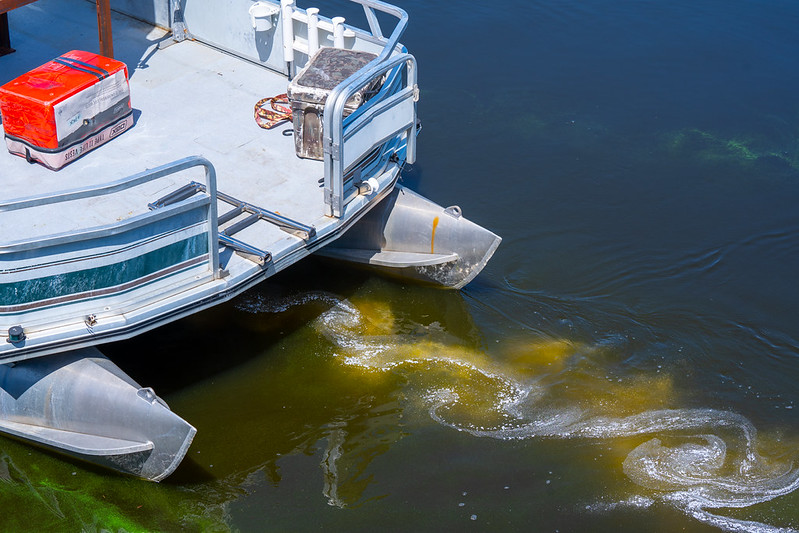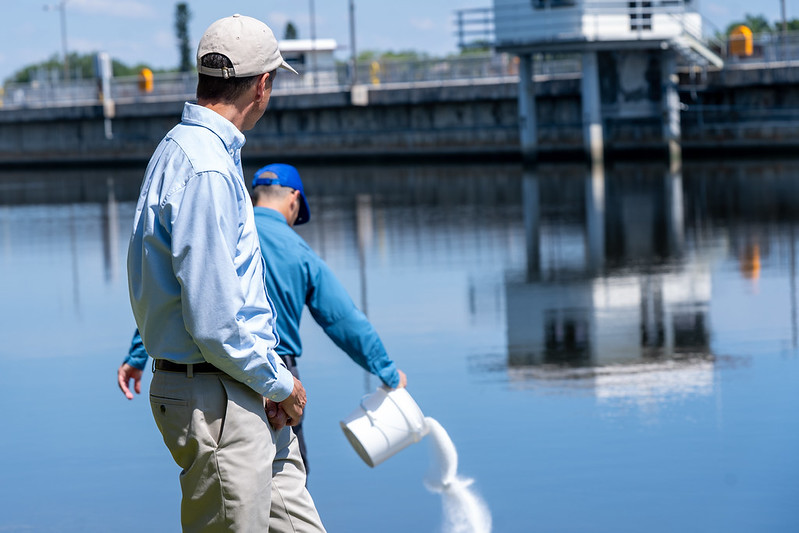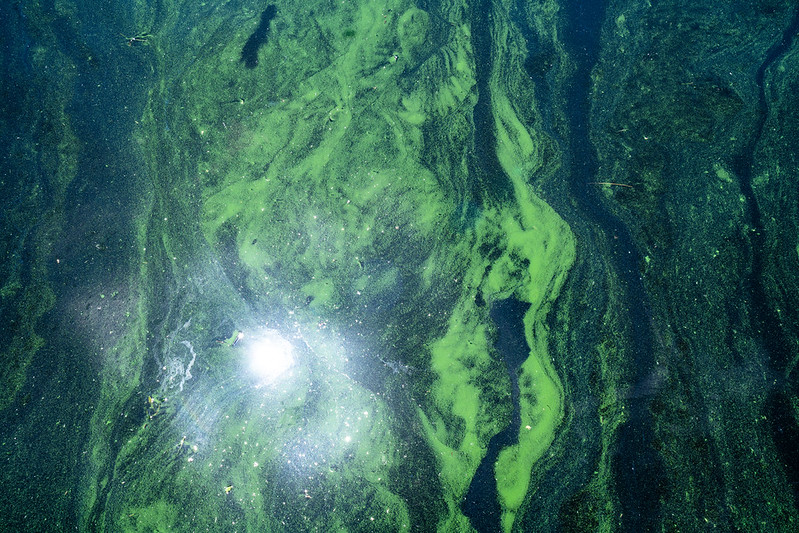DEEP DIVE: These chemicals kill toxic algae. But are they safe?
DEEP DIVE: These chemicals kill toxic algae. But are they safe?

Since 2020, when the state authorized the use of “innovative technologies” to combat harmful blue-green algal blooms, the South Florida Water Management District has added chemicals known as algaecides to its toolbox — and to the water.
Over the past three years the district has used thousands of pounds of algaecides to dissipate blooms. The use of these chemicals is actually decreasing, and experts say that so long as they’re being used as intended, they cause no problems.
So: Are they being used as intended? The answer, for the most part, is yes. But there have been apparent incidents of overuse — and some worry an over-reliance on these chemical “Band-Aids” could deter us from focusing on long-term nutrient reduction, the only real fix.
Busting the blooms
 The district typically uses the EPA-approved, granular product Lake Guard Oxy, made by Israel-based BlueGreen Water Technologies, to treat areas with cyanobacterial blooms.
The district typically uses the EPA-approved, granular product Lake Guard Oxy, made by Israel-based BlueGreen Water Technologies, to treat areas with cyanobacterial blooms.
Gov. Ron DeSantis posted on Twitter in 2021: “During our Israel trade mission in 2019, I signed an agreement with BlueGreen Water Technology to bring their innovative technology to Florida and help us fight the blue-green algae blooms in our lakes and waterways.”
The active ingredient in Lake Guard Oxy is sodium percarbonate. On contact with water, the product releases hydrogen peroxide, which prompts what’s called an “auto-catalytic cell-death cascade,” or a self-amplifying chain reaction of cell destruction.
As scary as that sounds, the by-products of the application — water and oxygen — are harmless to the surrounding environment, according to the maker, BlueGreen Water Technologies.
A research paper titled “An environmentally friendly approach for mitigating cyanobacterial bloom and their toxins” in the May 2018 edition of the journal “Science of the Total Environment” seems to back that up.
The study’s authors came to the conclusion that hydrogen peroxide-based algaecides (The study focused on a brand called PAK 27, which the district has also used.) “left no footprint … in water; hence, … is an eco-friendly compound.”
The district says a team of staffers uses information from a “robust network of scientific monitoring data” to assess potential algal blooms and decides when to treat an area based on “visual observations of the size and severity of the bloom and water quality sampling data.”
(To report an algal bloom to the district and the Florida Department of Environmental Protection, go to ReportAlgalBloom.com.)

It works, but too much is toxic
The treatments do work. A blue-green algal bloom at the Timer Powers Park boat ramp on the C-44 Canal at Indiantown had a microcystin level of 800 parts per billion, 100 times the level the federal Environmental Protection Agency considers safe to touch, when it was reported in early August 2023.
Within 24 to 48 hours of treatment with Lake Guard Oxy, the toxin level was 5 parts per billion, district officials reported at that month’s meeting of the SFWMD Governing Board.
The district says treatments “are conducted on a small scale” and applied per the manufacturer’s recommendation and in accordance with the product’s U.S. Environmental Protection Agency’s approved label.
Both – the small scale and the use according to the EPA-approved label – had better be true, because although Lake Guard Oxy is generally safe when used according to label instructions, incorrect use – particularly overuse – can pose risks to swimmers, fish and the environment.
Warnings on LakeGuard Oxy containers approved by the EPA in January 2023 note that the product is: “Corrosive. Causes irreversible eye damage and causes skin burns. May be fatal if swallowed. Harmful if absorbed through skin or inhaled. Do not get in eyes, on skin, or on clothing. Avoid breathing dust. Wear protective eyewear, such as goggles, face shield, or safety glasses.”
As for environmental hazards, the label notes: “This pesticide is toxic to birds. Do not apply this product or allow it to drift to blooming crops or weeds while pollinating insects are actively visiting the area.”
Like the name implies, “Lake Guard” was developed and is usually used on algae-infested ponds and small lakes. Use on massive blooms – like the ones that blanketed the St. Lucie River estuary with thick mats of toxic guacamole in 2018 – simply isn’t practical because of the massive amounts of algicide that would be needed.
That’s why BlueGreen Water Technologies recommends dosing blooms before they get out of hand. Instructions for using Lake Guard Oxy say it’s most effective “at early bloom stages, when harmful algal/cyanobacteria numbers are at 5,000 to 20,000 cells” per milliliter. But such a small concentration of algae can’t be readily seen in the water.
Instructions say that for “heavy blooms, when cyanobacterial scum or aggregates are visible to the naked eye” (more than 100,000 cells per milliliter), treat with doses between 30 and 98 pounds per acre.
‘Immediate relief’ or over-dosing?
An attempt to kill a large bloom — and what according to one expert was the resulting over-dosing — occurred in May 2021, when the district began a seven-day project using LakeGuard Oxy on active algal blooms along the Caloosahatchee River.
The district noted that the product had “shown promising results in other parts of Florida” and has “no water use restrictions.”
BlueGreen Water Technologies ended up treating a 48-mile segment of the C-43 Canal/ Caloosahatchee River, from Lake Okeechobee to Fort Myers with 5.1 tons of Lake Guard Oxy over 15 days, according to an Aug. 20, 2021, report by the company.
The company’s report said the first applications “provided an immediate relief for the residents, and the treatment eliminated the cyanobacterial scum and the associated odor, as well as other unpleasant conditions within 24-48 hours.”
The company also claimed to have reduced high levels of cyanotoxin, a dangerous toxin found in blue-green algae, to “below threshold advisory levels.”
But did the algaecide really work that well?
According to a story in the June 16, 2021, Fort Myers News Press under the headline “$750,000 and six tons of algaecide later, toxin warning signs are still up along the Caloosahatchee in Olga,” cyanobacteria toxins at the W.P. Franklin Lock were so high Lee County’s health department was urging people and their pets to stay out of the water along the Caloosahatchee’s south shore.
And that’s despite the company consistently over-dosing the bloom with algaecide, according to John Cassani, who was Calusa Waterkeeper at the time and is now a VoteWater.org board member.
“I observed the (LakeGuard Oxy) application near Franklin Lock and Dam for 13 consecutive days and witnessed numerous label violations,” Cassani said.
According to that EPA-approved LakeGuard Oxy warning label: “When a single application dose is below 30 lbs./acre, minimum retreatment interval is 12 hours. When a single application dose is between 30-98 lbs./acre, minimum retreatment interval is 24 hours. When a single application dose exceeds 98 lbs./acre, the minimum retreatment interval is 48 hours.”
BlueGreen Water Technologies reported that the “average dosage rate over the 15-day project was about 40 lb./acre,” so the minimum treatment interval should have been 24 hours.
Cassani told VoteWater: “I have a lingering memory that (the BlueGreen Water Technologies crew) had to keep reapplying and reapplying (the algaecide). They did more than one application per day for many of those days as the bloom persisted. They had to keep reapplying, more often than the label allowed.”

Complaint made, little done
Cassani said he contacted the Florida Department of Agriculture and Consumer Affairs, which he said cited the BlueGreen Water Technologies crew for not wearing proper personal protection devices, “but they didn’t go any further, they couldn’t answer my questions about the applications, because they said they couldn’t get the information they needed.”
(Click here to read the FDACS response to Cassani’s concens).
To be clear, Cassani said he “didn’t see any direct mortality” of animals, but BlueGreen Water Technologies “didn’t test for non-target impacts. So there’s no way we would have known if other plants and animals, in particular the zooplankton and phytoplankton at the bottom of the food chain, were affected.”
Ed Phlips, an algae expert at the University of Florida, has told VoteWater.org that hydrogen peroxide-based algaecides like LakeGuard Oxy are “like the peroxide you buy at Publix, (it) kills bacteria but can also kill other cells,” such as zooplankton and phytoplankton.
The “Science of the Total Environment” paper mentioned above also warned that high doses of algaecide (over 2.5 milligrams per liter) “exerted negative impacts on … phytoplankton species and zooplankton biota.”
Phlips also warned of possible “downstream effects” of algaecides: After the blue-green algae is killed, the bloom’s cells – which can contain the nutrients nitrogen and phosphorus — remain in the water.
“Other (organisms) can come in and take advantage of all those nutrients in the water,” Phlips said, potentially feeding other blue-green algae blooms in the St. Lucie River estuary or red tide in the Caloosahatchee River estuary.
Reducing use, reducing runoff
Fortunately, the district says it’s been reducing the use of algaecides over the past few years:
- 2023 – 43 treatments using a total of 7,216 pounds of algaecide on 98 acres of algal blooms (73.6 pounds per acre).
- 2024 – 28 treatments using 7,135 pounds of algaecide on 85 acres of algal blooms (84 pounds per acre).
- 2025 – six treatments using 890 pounds of algaecide on 10 acres of algal blooms (89 pounds per acre).
(You can track the sampling sites throughout the state and the treatments’ results on the DEP website: Floridadep.gov/AlgalBloom.)
According to the district, there has been less need to use algaecides to prevent massive blooms because of a significant decrease in the average annual volume of harmful discharges from Lake Okeechobee over the last six years: an 86% drop to the St. Lucie River and a 75% drop to the Caloosahatchee River.
What we really need to do…
Reducing the use of algaecides is good; reducing the runoff of fertilizer and sewage that causes blue-green algae blooms is the ultimate goal.
Another study on the effects of algaecides — “Comparative assessment of algaecide performance on freshwater phytoplankton: Understanding differential sensitivities to frame cyanobacteria management” — concluded: “Mitigative measures (e.g., algaecides) function as a “band-aid” solution bridging the time required until nutrient reduction targets are achieved.”
Even the CEO of BlueGreen Water Technologies, Eyal Harel, seems to agree. In 2019, the year DeSantis hired BlueGreen Water Technologies, Harel posted on Twitter: “DeSantis’ fight against algal blooms in Florida will fail. There is no question that preventing raw sewage and runoffs from spilling into waterways must be addressed.”
For its part, the district told VoteWater the use of algaecide to help stop small algal blooms from becoming big ones is “not intended to replace or reduce the need for long-term Everglades restoration and water quality improvement infrastructure” such as the Everglades Agricultural Area Reservoir Project, which will allow more water to flow south out of Lake Okeechobee, which in turn will improve water quality in the Everglades and reduce the need for harmful releases to the coastal estuaries.


